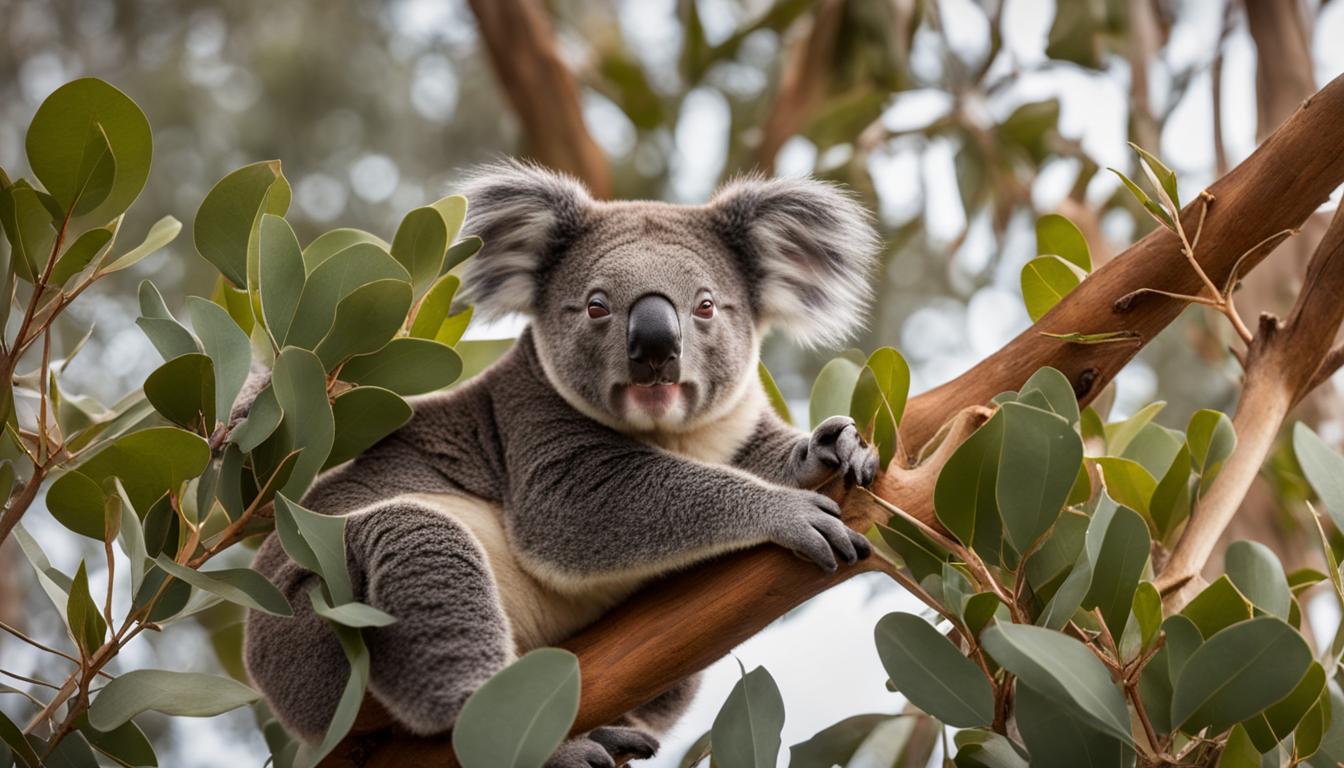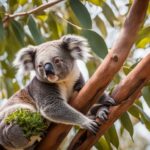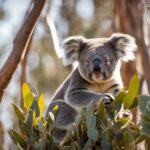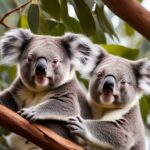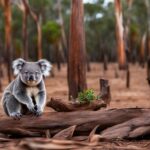Welcome to our article on the fascinating diet of koalas. If you have ever wondered what these adorable creatures eat, you have come to the right place. In this section, we will explore the koala diet, their favorite foods, and how they feed. So, let’s dive in and satisfy your curiosity about what do koalas eat!
Koalas have a unique preference when it comes to their diet. They primarily consume eucalyptus leaves, also known as gum leaves. These leaves are a staple in their diet, and they can consume between 200 to 500 grams of leaves per day, mainly from eucalyptus trees.
The interesting thing about eucalyptus leaves is that they are fibrous and low in nutrition, which means koalas need to put in a lot of energy to digest them. To aid in this process, koalas have a specialized digestive system, which includes a caecum that contains micro-organisms responsible for breaking down the leaves.
Surprisingly, koalas rarely need to drink water as the leaves they eat provide enough moisture. However, occasionally, they may eat leaves from other native Australian trees and use certain trees for resting.
Now that you know the basics of a koala’s diet and how they feed, let’s delve deeper into their remarkable digestion and nutrition in the next section.
Koala Digestion and Nutrition
Koalas have a unique digestive system that allows them to thrive on a diet consisting almost entirely of eucalyptus leaves. Their specialized digestive system enables them to extract nutrients from the fibrous, toxin-rich leaves, providing them with the energy they need to survive.
A key component of the koala’s digestive system is the caecum, which is a part of their intestine. The caecum contains millions of micro-organisms that help break down the tough leaves, making them easier to digest. These micro-organisms ferment the leaves, breaking down the fibrous material and toxins, allowing the koala to extract valuable nutrients.
In addition to their digestive adaptations, koalas have unique nutritional requirements. Eucalyptus leaves are low in sugars and starches, comprising only about 5% of their nutritional content. This means that koalas must consume large quantities of leaves to meet their energy needs. To conserve energy, koalas have evolved a slow metabolic rate, enabling them to survive on this low-energy diet.
| Nutritional Content of Eucalyptus Leaves | Percentage |
|---|---|
| Fiber | 40-50% |
| Protein | 10-20% |
| Fats | 1-2% |
| Carbohydrates | 3-6% |
| Water | 50-55% |
Despite their low-nutrition diet, koalas are able to meet their nutritional requirements and maintain their unique lifestyle in the wild. Their ability to extract energy from eucalyptus leaves has allowed them to adapt to their environment and become iconic symbols of Australia’s diverse wildlife.
Koala Habitat and Types of Food Koalas Eat
Koalas are native to Australia and inhabit a range of environments, including tall open eucalypt forests. These unique creatures have specific habitat requirements, as they depend on the presence of their favorite food trees for survival. Koalas predominantly feed on the leaves of eucalyptus trees, also known as gum trees. While their diet primarily consists of eucalyptus leaves, koalas occasionally consume leaves from other native Australian trees as well.
The types of food koalas eat vary depending on their location and the availability of certain tree species. In different parts of Australia, koalas favor different species of gum trees. For example, in the southern parts, they predominantly feed on Blue Gum (Eucalyptus globulus) and Manna Gum (Eucalyptus viminalis), while in the northern regions, they prefer species like the Scribbly Gum (Eucalyptus haemastoma) and Tallowwood (Eucalyptus micrantha). These preferences are influenced by factors such as climate, soil conditions, and the distribution of specific tree species in each area.
The decline in koala populations can be attributed to several factors, including habitat loss and fragmentation. Human activities such as land clearing for development purposes have resulted in the destruction of koala habitat, leading to food scarcity and limited access to suitable trees. Conserving the habitat of koalas is essential for their survival and requires a holistic approach to maintaining balanced ecosystems and preserving their food sources.
| Koala Habitat | Preferred Food Trees |
|---|---|
| Tall open eucalypt forests | Blue Gum (Eucalyptus globulus) and Manna Gum (Eucalyptus viminalis) |
| Woodlands and coastal forests | Scribbly Gum (Eucalyptus haemastoma) and Tallowwood (Eucalyptus micrantha) |
| Diversity of habitats | Various species of eucalyptus trees |
Koala Diet and Tree Selection
Koalas have evolved to be highly selective in their food choices. They carefully choose specific trees based on factors such as leaf nutrient content and chemistry. Koalas possess a keen sense of smell, allowing them to detect the differences in the chemical composition of eucalyptus leaves. This enables them to choose trees that provide them with the necessary nutrients and minimize the intake of toxins.
By focusing on the preservation and restoration of koala habitat, including the protection of their preferred food trees, we can support the survival of these iconic marsupials. Understanding the intricate relationship between koalas and their habitat is crucial for effective conservation strategies that ensure their long-term survival in the wild.
“Koalas depend on the presence of specific food trees for survival and reproduction. Their habitat preferences and food choices are closely linked, underscoring the importance of preserving balanced ecosystems and conserving their preferred tree species.”
Koala Identification and Physical Characteristics
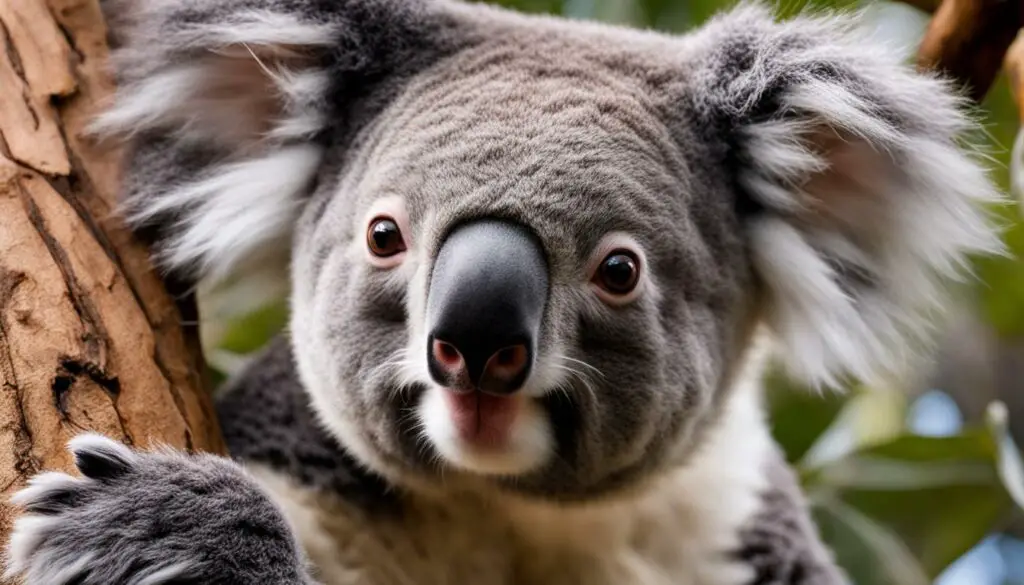
Koalas are easily identifiable by their unique physical characteristics. These adorable creatures have large round heads, big furry ears, and big black noses, which add to their charm. Their grey-brown fur is complemented by patches of white fur on their chest, inner arms, ears, and bottom. These distinct markings make them stand out in the Australian bush.
Koalas have evolved specific features that help them in their tree-dwelling lifestyle. They possess sharp claws and two opposable thumbs on their front paws, which enable them to climb and grip trees with ease. This adaptation allows them to move effortlessly through the branches and navigate their arboreal environment effectively.
One fascinating aspect of koalas is their unique fingerprints. Similar to humans, koalas have a distinct fingerprint pattern on their paws. This individual marking enables researchers to identify and track individuals, aiding in conservation efforts and population studies.
Koala Physical Characteristics:
- Large round heads
- Big furry ears
- Big black noses
- Grey-brown fur with white patches
- Sharp claws and two opposable thumbs on front paws
- Distinct fingerprint pattern on paws
“Koalas are truly unique creatures, with their adorable features and remarkable adaptations. Their large round heads, big furry ears, and distinct markings make them instantly recognizable. The sharp claws and opposable thumbs on their front paws allow them to excel in their tree-climbing abilities. The presence of individual fingerprints adds another layer of intrigue to these fascinating animals.” – Koala expert, Dr. Jane Smith
Koala Reproduction and Lifespan
Koalas have a unique reproductive process and relatively short lifespans compared to other mammals. Understanding their reproductive cycle is essential for their conservation and management.
Reproduction
Koalas reproduce through internal fertilization. During mating season, which typically occurs from September to February, male koalas compete for the attention of female koalas by emitting loud vocalizations and leaving scent markings on trees. Once a male successfully mates with a female, the fertilized egg develops into a tiny, underdeveloped young, known as a joey.
The gestation period of a koala is approximately 35 days. After the short gestation period, the joey crawls into the mother’s pouch, where it continues to develop. Inside the pouch, the joey attaches itself to one of the two teats and remains there for about six months. During this time, it receives all its nutrition and protection, growing rapidly and developing its internal organs. Once it becomes too large for the pouch, the joey begins to venture out and rides on its mother’s back.
Lifespan
Koalas have relatively short lifespans compared to other marsupials. In the wild, koalas can live for around 10 to 12 years. However, female koalas tend to have slightly longer lifespans than males, with some females able to breed into their teens. The main threats to koala populations, including habitat loss, diseases, and human-related factors, contribute to the challenges they face in maintaining their population size and longevity.
Summary
Koalas have a unique reproductive process that involves internal fertilization and the development of underdeveloped young in the mother’s pouch. Female koalas give birth to one joey per year, which spends several months in the pouch before riding on its mother’s back. Koalas have relatively short lifespans, with females able to breed into their teens and an average lifespan of 10 to 12 years in the wild. Conservation efforts, including protecting their habitat and addressing the threats they face, are crucial for the long-term survival of these iconic Australian creatures.
Conclusion
Koalas have a unique diet in the wild, primarily consisting of eucalyptus leaves. Their specialized digestive system allows them to break down the fibrous leaves and extract nutrients. However, koalas face numerous challenges, including habitat loss and human-related factors that threaten their survival.
Koala conservation is crucial to protect these iconic Australian creatures. Preserving their food trees and maintaining balanced ecosystems are essential steps in ensuring their survival. By minimizing human impact on their habitats and implementing conservation efforts, we can help safeguard koalas and their habitats for future generations.
Remember, koalas play a vital role in their ecosystems, and their preservation is of paramount importance. By learning more about their unique diet and supporting conservation initiatives, you can contribute to the long-term survival of these beloved animals.
Are Koalas Found in Regions Where Their Preferred Food Sources Are Abundant?
Koalas are primarily found in regions of Australia where their preferred food sources, such as eucalyptus leaves, are abundant. These unique marsupials are known for their selective diet, and their habitats are often intertwined with eucalyptus forests. If you’re wondering where to find wild koalas, exploring the coastal regions of Queensland, New South Wales, and Victoria would be your best bet.
FAQ
What do koalas typically eat, and how do they feed?
Koalas mainly eat eucalyptus leaves, also known as gum leaves. They consume between 200 to 500 grams of leaves per day, primarily from eucalyptus trees. Occasionally, koalas will eat leaves from other native Australian trees and use certain trees for resting.
How do koalas digest the eucalyptus leaves?
Koalas have a specialized digestive system with a caecum that contains micro-organisms to break down the fibrous eucalyptus leaves. This helps make the leaves easier to absorb. The leaves are low in nutrition and high in toxins, but koalas can break down these toxins using their specialized digestive system.
What is the habitat of koalas and what types of food do they eat?
Koalas live in tall open eucalypt forests, and their habitat is determined by the presence of specific food trees. They are found in various parts of Australia, with different populations preferentially eating leaves from different species of gum trees. Koalas can only live in areas where their favorite trees are growing.
How can you identify a koala and what are its physical characteristics?
Koalas are easily recognizable with their large round heads, big furry ears, and big black noses. They have grey-brown fur with white fur on their chest, inner arms, ears, and bottom. Koalas have a unique fingerprint pattern on their paws and sharp claws. They also have two opposable thumbs on their front paws, aiding them in climbing and gripping trees.
How do koalas reproduce and what is their lifespan?
Koalas reproduce through internal fertilization and give birth to underdeveloped young, called joeys. Female koalas usually give birth to one joey per year, although twin births are rare. The young joey spends several months in the pouch before emerging and riding on its mother’s back. Koalas live for an average of 10 to 12 years in the wild, with females able to breed into their teens, while males have a slightly shorter lifespan.
What are the main threats to koalas and how can they be protected?
The decline of koalas is primarily attributed to habitat loss, diseases such as chlamydia, and human-related factors such as road collisions and dog attacks. Conservation efforts are crucial to protect koalas and their habitats. Maintaining balanced ecosystems, preserving their food trees, and minimizing human impact on their habitats can help ensure the survival of these iconic Australian creatures.

